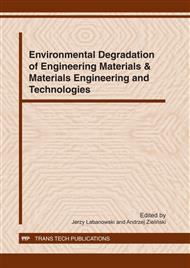p.155
p.163
p.169
p.175
p.179
p.185
p.193
p.201
p.207
Positive Effect of Hydrogen Treatment in Titanium Ti-6Al-4V Alloy
Abstract:
Positive nature of the effects of hydrogen on the properties of titanium alloys is manifested in the high temperature hydrogen treatment (HTM - Hydrogen Treatment of Materials), where hydrogen is temporary alloying component. This is possible because of the high values of diffusion coefficients can be easily introduced into the titanium and it just as easily removed. Titanium and its alloys exhibit a high affinity for hydrogen absorption capacity, about 60% at. hydrogen at 600 °C. The hydrogen in titanium alloy is present in the form – an interstitial solution or titanium hydride. Since the specific volume of titanium hydride is about 13 ÷ 17% higher compared to α phase, it is high stress in the crystal lattice of this phase leads to local plastic deformation and large deformation phase. The paper presents the results of the possibilities of hydrogen using as a temporary alloying element in Ti-6Al-4V alloy. Treatment of hydrogen alloy consisted of three stages: hydrogenation in hydrogen gas atmosphere at 650 °C, a cyclic hydrogen-treatment (3 cycles 650 °C or 950 °C to 250 °C) and a dehydrogenation in vacuum (550 °C). It was shown that hydrogen affects appreciably changes the microstructure of surface layer of the tested titanium alloy. The aim of this study is thus to determine the effect of hydrogen on the two-phase microstructure, hardness, and corrosion resistance of the titanium alloy Ti-6Al-4V due to high-temperature hydrogen treatment.
Info:
Periodical:
Pages:
179-184
Citation:
Online since:
December 2011
Authors:
Price:
Сopyright:
© 2012 Trans Tech Publications Ltd. All Rights Reserved
Share:
Citation:


